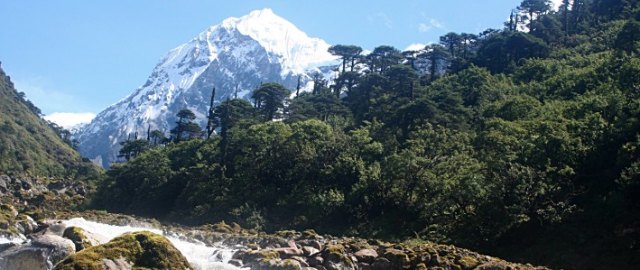
Duration : 11 Days
Route : Nambu → Sangkhola → Naya Patal → Lower Yambong → Lam Pokhari → Pare Megu → Dhor → Chewabhanjyangi → Uttarey → Gangtok / NJP
This Sikkim Trek through the ever green Singalila range which spans across the borders of West Bengal, Sikkim and Nepal. Verdant valleys, gushing rivers, dazzling lakes, thick forests teeming with wildlife and birds characterize this stupendous mountain range. Yambong valley is one such treasure trove tucked in a remote part of West Sikkim.
The trek starts from the village of Nambu, situated at the base of the valley. Over the next four days our path ascends through the Yambong valley, criss-crossing the Rimbi river and meandering through the densely forested slopes. Stupendous views of the Khangchendzonga and Everest ranges beckon us once we reach our high point named Daphe Bhir. For the next three days we walk amongst rhododendron thickets over the Singalila ridge, with the Khangchendzonga and Everest ranges becoming our constant companions. In spring time the entire slopes are converted into a riot of colour as the rhododendrons come in full bloom.
Trek Grade : This sikkim trek is graded as Moderate.
Some experience is advantageous though some of these trips may be suitable for beginners as well. There may be considerable altitude gain in a day’s trek. These treks may be up to 10 days of walking with up to 6hrs (avg.) of walking each day. Altitudes regularly reach 15,000 feet and may gradually reach up to 18,000 feet.
Best Season : Late March to April is the best period to enjoy the blooming rhododendrons. Mid October to mid December is excellent for mountain views.
Itinerary
Day 1 Nambu
Pickup from Bagdogra / NJP / Gangtok and drive to trek base village Nambu.
Day 2 Sangkhola
Trek for 4 hours to reach Sangkhola.
Day 3 Naya Patal
Trek for 5 hours to reach Naya Patal.
Day 4 Lower Yambong
Trek for 7 hours to reach Lower Yambong.
Day 5 Lam Pokhari
Trek for 3 hours to reach Lam Pokhari.
Day 6 Lam Pokhari
Rest Day.
Day 7 Pare Megu
Trek for 6 hours to reach Pare Megu.
Day 8 Dhor
Trek for 6 hours to reach Dhor.
Day 9 Chewabhanjyangi
Trek for 8 hours to reach Chewabhanjyangi.
Day 10 Uttarey
Trek for 3 hours to reach Uttarey.
Day 11 Gangtok / NJP
Drive to Gangtok / NJP for your connections.
Community Initiative
Traditionally, nomadic yak herding and trade in medicinal and aromatic plants were the main source of livelihood for the villagers in the Yambong Singalila region. Albeit over grazing by the yak herds over a period of time became the single largest threat to the fragile alpine ecosystem. Further, use of Rhododendron and Juniper in large quantities for firewood, poaching of wildlife and smuggling of endangered medicinal plants were increasingly threatening the environment.
In early 2005 TMI- India ((The Mountain Institute) initiated a community based tourism project to provide the local people with an alternative means of livelihood. The local communities put in a joint effort to promote tourism along the Yambong Singalila Trek. The Yambong Ecotourism Committee (YEC) was initially constituted to manage this initiative. A total of 146 porters were enlisted from the neighboring villages and several trainings for developing guides and cooks were undertaken. All yak herders and ranchers were made a part of this tourism venture and associated with Yambong Ecotourism Committee. In 2005, there were more than 1200 yak grazing in the alpine meadows, but after sensitizing the herders about the negative environmental impacts of over grazing, the number of yaks went down by 50% in just one year. Today there are only 100 odd yaks as the herders have realized that they can earn almost the same income from tourism related services as they used to earn from herding in 12 months. The herders who used to depend on natural resources are now earning income in a non-extractive manner. They also realize that sustenance of tourism is interconnected with the preservation of the environment, giving them an incentive to maintain the ecosystem.


No comments yet.